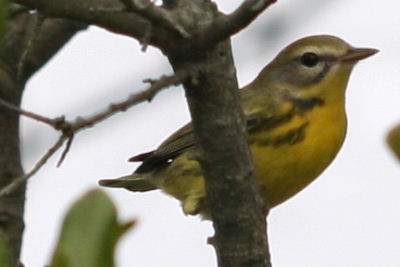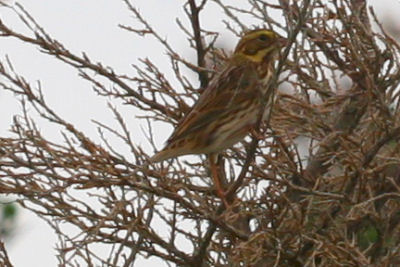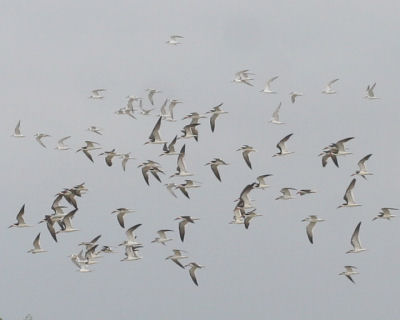…Warblers.
At least this year. What other reaction can I have to the evil little bird snubbing me at Central Park, avoiding me at Floyd Bennett Field, and leaving me standing in the rain for two hours at Muttontown Preserve? That’s right, Muttontown Preserve. But before I get to the whole sordid story let me share with you what Mike missed after some lousy birding at Jones Beach.

first fall female Prairie Warbler

male Common Yellowthroat

Savannah Sparrow

Black Skimmers and Forster’s Terns
Anyway, while I was enjoying the birds above, another birder was finding a Connecticut Warbler at 10:15 at the Muttontown Preserve, a park in northern Long Island. By noon a second birder had also seen the bird, and at 1:17 posted the information to the New York listserv. At 1:25 I received a call from Rich, who knew I was birding around New York, and he read off the directions to the bird which involved the intersection of two roads, the equestrian entrance, a corral, trails through fields, and an “X” marking the spot.
Either way, at 2 I arrived at Muttontown and I began my search in a light drizzle. By 2:10 I was at the “X” feeling like I was on a treasure hunt. But the treasure wasn’t buried in dirt; it was hidden in acres of waist-high to chest-high brush that the horse-poop laden trail bordered. And it wasn’t the only treasure around: Common Yellowthroats kept fooling me as did Song Sparrows and basically everything else that moved. Several times I found myself seeing something out of the corner of my eye only to find butterflies or dragonflies. Talk about frustrating!
Then I heard an odd chip note from behind me, where thick trees stood instead of brush. I can’t say I know what a Connecticut Warbler’s chip note sounds like but I assumed that what I was hearing was it. I listened carefully, occasionally trying to imitate the chip note with the hope of eliciting a response. It worked! I managed to figure out the exact location the note was coming from (about twenty feet away on the ground beneath some trees, screened by thick brush) and then caught some movement. With the bins up the movement revealed itself as two pink warbler legs walking along the ground, with the rest of the bird obscured by sticks. Success! Connecticut Warblers are one of very few warbler species that walk instead of hopping. I was ecstatic but I wanted to see more than legs. My silent plea was answered when the bird stepped out from behind the sticks and revealed itself. An Ovenbird. Sigh. They are one of the other “very few warbler species that walk instead of hopping.”
What are the odds of an Ovenbird inhabiting the same spot as a Connecticut Warbler, chipping enough for me to notice and find it, and then revealing itself legs-first? A thousand to one? A million to one?
But even after this crushing blow I soldiered on, staying for another hour, tracking every movement, and cursing the rain, Big Years, and, most especially, the diabolical Connecticut Warbler. At 4 PM I gave up and started the long drive upstate without Connecticut Warbler checked off my year list and vowed not to chase another. They will remain unseen, unchecked, and unloved (unless I find one myself).













You caught my attention with the I hate Connecticut since I live here.-At least you’re at the point of trying to get a Connecticut Warbler.-I’ve seen a Mourning Warbler, but that’s about as far as it goes.